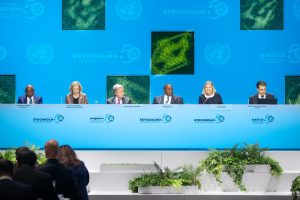- SIWI – Leading expert in water governance
- /
- Latest
- /
- Why a tree falls in Brazil when a dam is built in the Mekong
Why a tree falls in Brazil when a dam is built in the Mekong
Nexus thinking is complex, I know. Trying to create synergy from water, energy and food, instead of competition, is not an easy task – not to mention that there are probably as many definitions of “the nexus” as there are nexus researchers
The food is not just food, energy is not just energy, and water is not just water. The nutritional composition of food is at least as important as the mere amount of calories people have access to. Energy includes considerations concerning price, greenhouse gas emissions and other economic or environmental priorities. Even water of different qualities, with different sediment flows, in a reservoir or freely flowing, salty or fresh has completely different potential of being good or harmful. And finally, which governance structures and decision-making processes are available for transparent handling of the obvious trade-offs?
In a recent Water Dialogues seminar, hosted by Swedish Water House (SWH) and the International Centre for Water Cooperation (ICWC), Jamie Pittock, visiting researcher at ICWC, brilliantly showcased how hydropower development along the Mekong river not only has serious impacts on the food security for people living further downstream, but even pushes for land use changes in other parts of the world. Despite the unique role of the Mekong River Commission for transboundary water management, dams are still being planned and built, affecting water quality and availability downstream and also prohibiting migration of fish species that, as a consequence, disappear from the basin. This loss for the local fishery cannot be compensated for by grown fish populations in the reservoirs.
So how can this food source be replaced? Some governments have chosen to support additional rice production, but this requires dikes and other infrastructure to regulate water flows in the plains. And it requires land areas that are not available.
Another problem in this solution is that rice does not replace the protein provided by fish. Some progress has been made in supporting pork farming instead – but even there, the problem is that pork is not a sufficient replacement for fish. Pittock and his colleague analyzed the population’s access to the amino acid Lysine, which is part of all proteins. Lysine is a critical micro-nutrient in children’s brain development. Pork has a much lower Lysine and protein content than fish and even poultry or beef. So is pork really the way to go?? Both rice and pork production need investments that will lock the agricultural development in a certain path for quite some time, so demand-based and transparent decision-making becomes more and more essential.
There are many other aspects that need to be taken into account: Aquaculture can replace some of the wild fish – and has proven its potential in comparable cases in India. But Jamie Pittock fears that the aquaculture fish will be too expensive for the poorest. Additionally, modern fish production uses fillets only, with much lower protein content than the traditional consumption of the entire fish. Potential exports also support only those who have access to investments and infrastructure.
And finally – already today, the import of fodder (soy cakes most of all) is increasing significantly, showing that pasture-based livestock is replaced by stable-held, fodder-based meat production. This of course requires smaller areas in the nations along the lower Mekong – but the problem is just exported to the feed-exporting countries like India, Argentina and Brazil. With all the implication this has for land-use changes in those places.
Indeed, Jamie Pittock succeeded in thoroughly explaining why a tree falls in Brazil when a river is dammed in the Mekong. And why despite all adaptability of the socio-economic systems, this will mostly affect the food security and nutrition quality of the poorest.
The solutions? Some hope was expressed about the role of international mechanisms like the UN-Watercourses Convention and even growing attention within the Mekong River Commission. But nevertheless, the national governments need to explain how they want to enhance food security and how this can be delivered on the local planning level, while facing limited access to land and water.








